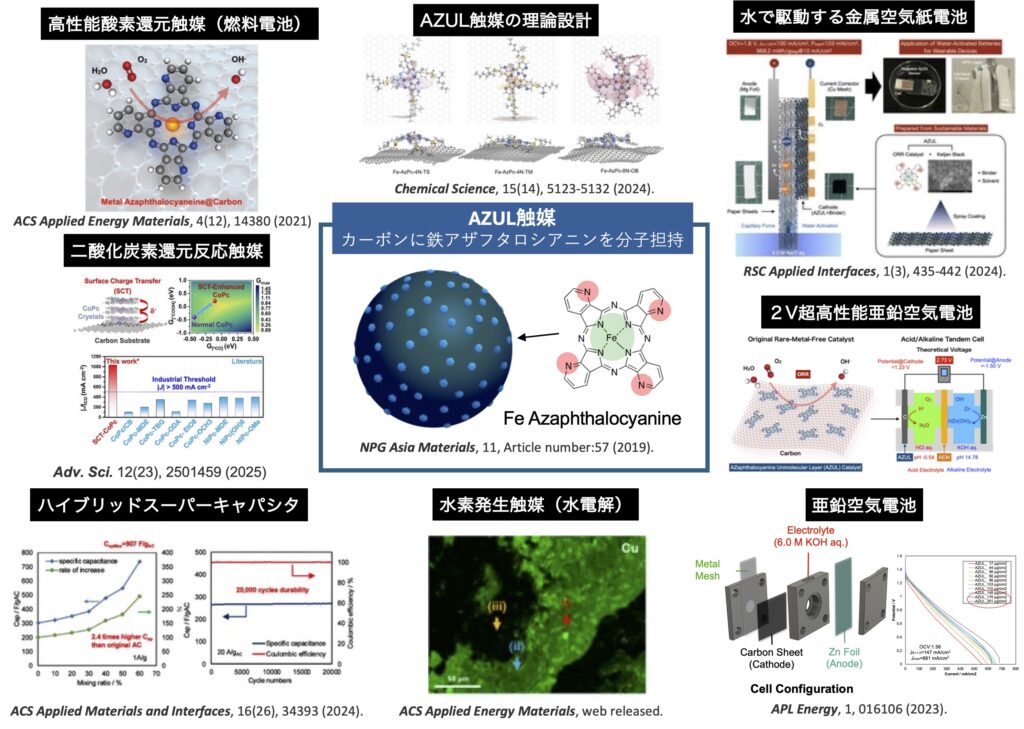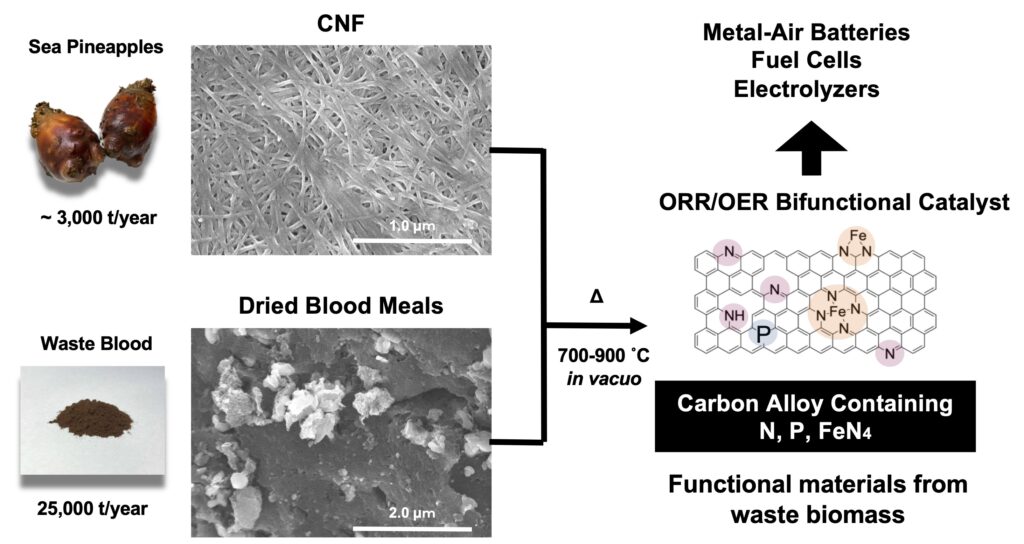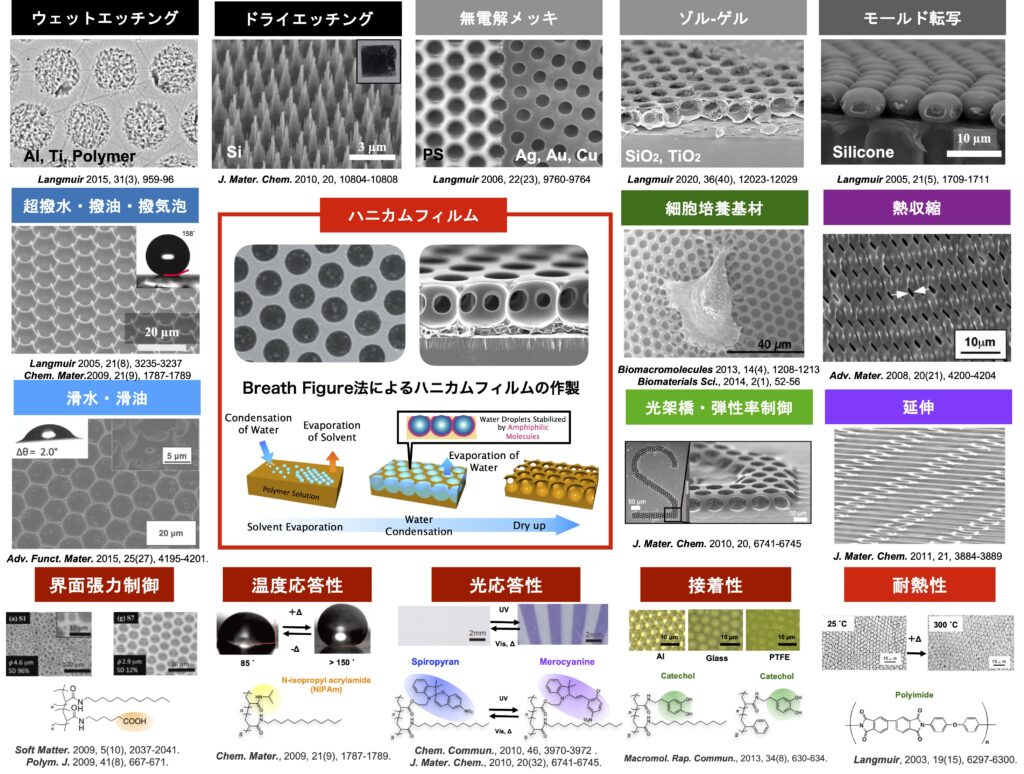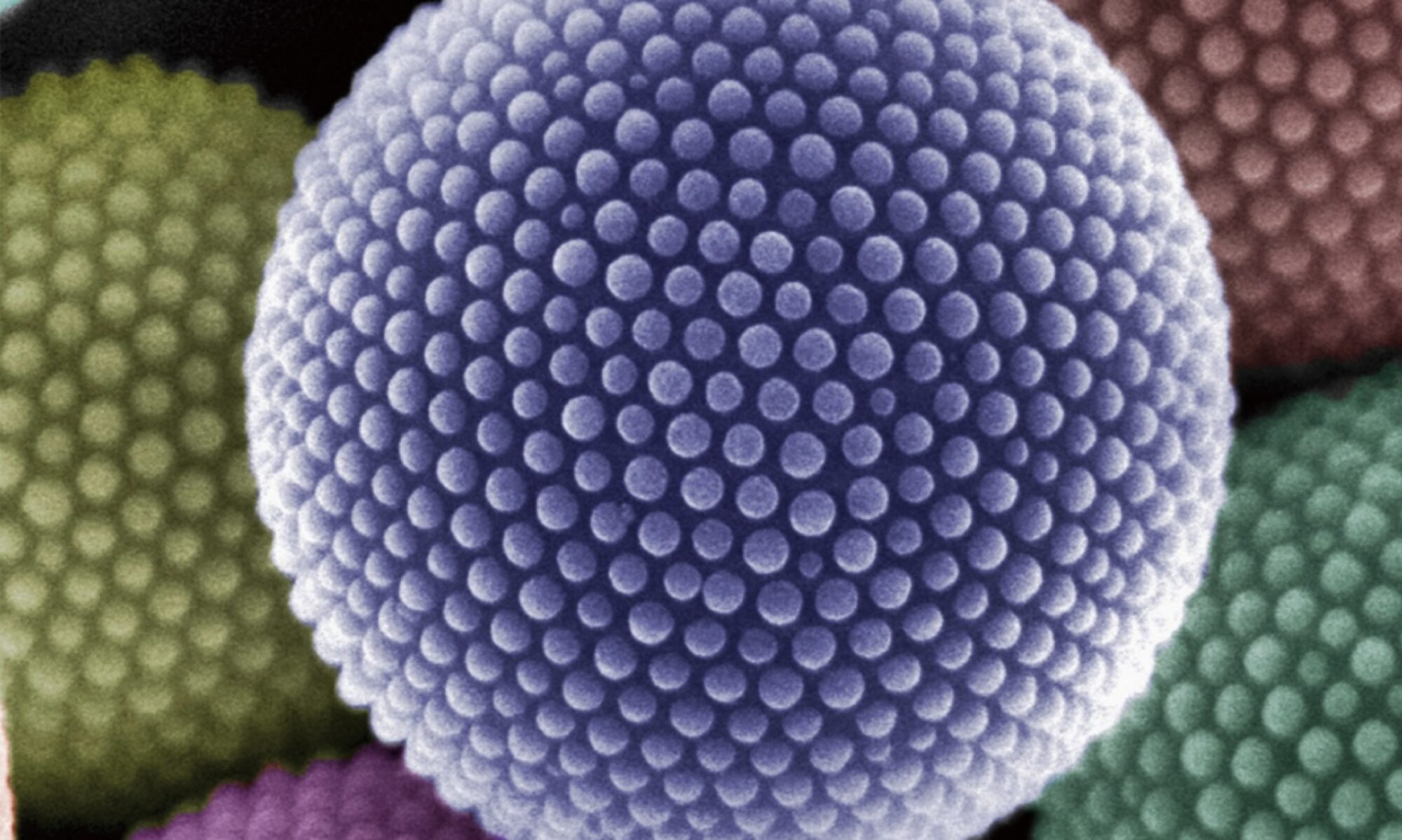
Energy and Material Conversion
エネルギー・物質変換技術
The “AZaphthalocyanine Unimolecular Layer (AZUL)” catalyst, composed of metal azaphthalocyanine—a blue pigment—supported on carbon, is a low-cost electrocatalyst that can be synthesized without resource constraints and exhibits high activity due to molecular-level active sites.
Based on insights gained from this catalyst, we are developing electrocatalysts for various reactions, including the oxygen reduction reaction (ORR) in fuel cells and metal-air batteries, the hydrogen evolution reaction (HER) in water electrolysis, and CO₂ electrochemical reduction (ECR) for converting CO₂ into valuable organic compounds.
In addition, we are working on the development of various innovative energy devices, such as a novel zinc-air battery with an open-circuit voltage exceeding 2 V, a metal-air paper battery triggered by water absorption in paper, and new electrolysis systems with ultra-low overpotentials.
青色顔料である金属アザフタロシアニンを炭素に担持した「AZaphthalocyanine Unimolecular Layer (AZUL)」触媒は分子レベルの活性点による高活性を有し、資源制約なく低コストに合成できる電気化学触媒です。
本触媒の知見をベースに燃料電池や金属空気電池の正極反応である酸素還元反応(ORR)や水電解の反応である水素発生反応(HER)、二酸化炭素から有用有機化合物を合成するCO2電解還元(ECR)用の触媒開発を行っています。
また、2Vを超える開放電圧を有する新しい亜鉛空気電池や紙による吸水をトリガーとした金属空気紙電池、さらには新しい低過電圧電解システムなど、様々な革新的エネルギーデバイスの開発を行っています。

Resource Circulation
資源循環技術
The effective utilization of limited resources is essential for the continued survival of humanity. In the Sanriku region, the shells of sea squirts—one of the area’s local specialties—are disposed of as industrial waste. Similarly, in the livestock industry, discarded blood is a major source of river pollution, requiring significant costs and energy for its treatment.
We focused on the unique biological feature that sea squirts, despite being animals, produce cellulose, which becomes concentrated in their shells. Notably, the cellulose derived from sea squirt shells exhibits a higher degree of crystallinity compared to wood-based cellulose. Additionally, we recognized that discarded blood contains a variety of biologically derived materials, such as hemoglobin, that can function as catalysts.
By co-pyrolyzing these two waste materials, we discovered a new catalyst—“Nano Blood Carbon”—that exhibits high catalytic activity for both the oxygen reduction and oxygen evolution reactions. This catalyst, which does not rely on precious metals with limited availability, is gaining attention as a technology for producing highly active electrocatalysts from waste biomass.
限りある資源を有効活用することは人類が存続していく上で重要です。三陸地域の特産であるホヤの殻は産業廃棄物として廃棄されています。また、畜産業においても廃棄血液は河川の汚染の原因となることから、その処理に大きなコストとエネルギーが使われています。
我々はホヤが動物であるにもかかわらずセルロースを産生し、殻に濃縮されていること、さらにホヤ殻由来のセルロースの結晶化度が木質と比べ高いことに注目しました。さらに廃棄血液中にはヘモグロビンを始め、触媒として機能する生物由来材料が多く含まれている事に着目し、この2つを混合焼成することで、高い酸素還元・発生反応活性を持つ「ナノ血炭」触媒を見出しました。
本触媒は資源制約のある貴金属を使わず、廃棄バイオマスから高活性な触媒を作る技術として注目されています。(日本テレビ 「所さんの目がテン」で金属空気紙電池共に紹介されました link)

Polymer Particles
高分子微粒子作製技術
We have developed a method for producing diverse polymer microparticles using our uniquely discovered technique called “Self-Organized Precipitation (SORP).” In particular, we are working on nanostructure control through phase separation from polymer blends and block copolymers, and are collaborating with mathematicians to construct theoretical models for these systems.
In addition, by creating hybrid microparticles incorporating inorganic or metallic nanoparticles, we are developing materials for surface-enhanced Raman scattering (SERS) substrates and sensor particles for detecting infectious diseases such as influenza and COVID-19, along with corresponding diagnostic systems.
More recently, we have succeeded in synthesizing low surface energy microparticles as an alternative to PTFE, accelerating efforts toward fluorine-free binder materials.
独自に見出した「自己組織化析出(Self-ORganized Precipitation, SORP)」法を用いて多様な高分子の微粒子を得る手法を開発しています。特にポリマーブレンドやブロック共重合体などから、相分離構造によるナノ構造制御の手法と数学者と共にその理論モデルを構築しています。また、無機・金属ナノ粒子とのハイブリッド微粒子を作製することで、表面増強ラマン散乱(Surface Enhanced Raman Scattering, SERS)の基材となる微粒子や、インフルエンザやCOVID-19などの感染症を検知するセンサー微粒子と検査システムの開発を行っています。
さらにごく最近ではPTFEに代わる低表面エネルギー微粒子の作製にも成功し、バインダー材料のフッ素フリー化に向けた取り組みを加速しています。

Biomimetic Adhesive Polymers
バイオミメティック接着ポリマー
Mussels and barnacles are known to adhere to a wide range of materials even in high-salinity seawater. This strong adhesion is due to the secretion of specialized adhesive proteins by these organisms. These proteins contain catechol groups, which can form a variety of interactions with material surfaces—including hydrogen bonding, metal chelation, reactions with amines and thiols, as well as hydrophobic interactions. These diverse interactions are believed to be the source of their broad adhesion capabilities.
We are exploring new functionalities by synthesizing random copolymers and block copolymers containing catechol groups, leveraging both the unique chemical properties of catechols and the structural versatility of polymers.
Our research includes the development of adhesive polymers capable of bonding heterogeneous materials, dispersants for stabilizing PTFE particles in water, and block copolymer materials that utilize the reducing power and proton transfer capabilities of catechol groups.
ムール貝やフジツボは高塩濃度の海水中で多様な材料に接着します。これは、ムール貝やフジツボが多様な材料に接着する接着タンパクを分泌しているからです。接着タンパク中に含まれるカテコール基は、水素結合や金属のキレート、アミンやチオール等との反応に加え、疎水性相互作用など、多様な相互作用を材料表面と形成することから、多様な材料への接着力の起源と言われています。
我々はカテコール基を導入したランダムコポリマーやブロック共重合体を合成することで、カテコール基の機能性とポリマー構造を利用した機能開拓を進めています。
多様な異種材料界面を接着する接着ポリマーや、PTFE粒子を水に分散させるための分散剤、カテコール基の還元能やプロトン移動能を利用したブロック共重合体材料の開発などを進めています。

Honeycomb Films
ハニカムフィルム
We are developing a method for fabricating porous films from various functional polymers using the “Breath Figure” technique, in which humid air is blown over a polymer solution during film formation. Water droplets that condense from the air serve as a template, resulting in a porous structure. Our research encompasses the fabrication process, manufacturing technology, and potential applications of these porous polymer films.
高分子溶液を塗布成膜する際に湿度の高い空気を吹き付けることにより、空気中から結露した水滴を鋳型として多孔質膜を得る「Breath Figure」法を用いて、多様な機能性高分子から多孔質膜を得る手法とその製造技術および応用展開に関する開発をしています。

